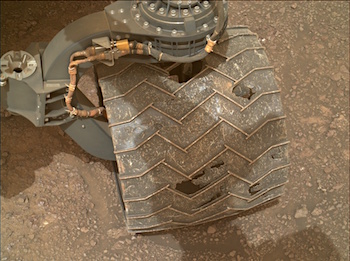 Sols 2293-94, January 17, 2019, update by MSL scientist Michelle Minitti: It has been a productive stay at the “Rock Hall” drill site. The number and diversity of analyses performed on the drill target and drilled sample itself – mineralogy from CheMin, organics and volatiles from SAM, chemistry and spectral characteristics of the bedrock, drill tailings and excess drilled sample from APXS, ChemCam, and Mastcam – speak to the importance of samples we so painstakingly extract from Mars. After acquiring an image of the drill hole using MAHLI to pinpoint APXS’s placement over the drill tailings the evening before, we depart for our next adventure – the clay-bearing unit. This unit, which lies between us and the next set of mesas further up Mount Sharp, exhibits a strong spectral signature of clay minerals from orbit. As clays are associated with the action of water and, typically, that of neutral pH waters, we are keen to learn about the nature and origins of the clays and the rocks that host them.
Sols 2293-94, January 17, 2019, update by MSL scientist Michelle Minitti: It has been a productive stay at the “Rock Hall” drill site. The number and diversity of analyses performed on the drill target and drilled sample itself – mineralogy from CheMin, organics and volatiles from SAM, chemistry and spectral characteristics of the bedrock, drill tailings and excess drilled sample from APXS, ChemCam, and Mastcam – speak to the importance of samples we so painstakingly extract from Mars. After acquiring an image of the drill hole using MAHLI to pinpoint APXS’s placement over the drill tailings the evening before, we depart for our next adventure – the clay-bearing unit. This unit, which lies between us and the next set of mesas further up Mount Sharp, exhibits a strong spectral signature of clay minerals from orbit. As clays are associated with the action of water and, typically, that of neutral pH waters, we are keen to learn about the nature and origins of the clays and the rocks that host them.
Our first move is a series of bumps that will scoot us forward 2 m as we image the wheels that will carry us to the clay-bearing unit and beyond. The process, called full MAHLI wheel imaging, involves poising MAHLI obliquely above the wheels to image them, stowing the arm, bumping forward a few tens of centimeters to bring the next segment of wheel into view, unstowing the arm, and imaging the wheels once again. It takes 4 small bumps to fully image… [More at link]








